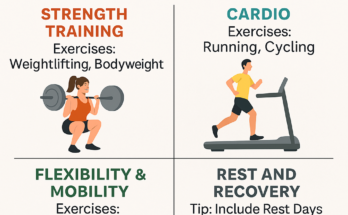introduction
Reaching your 40s doesn’t mean slowing down—it means getting smarter about how you care for your body. With a few intentional changes in your routine, staying fit after 40 is not only possible but can be deeply rewarding. Here’s your practical guide to staying strong, energetic, and healthy well into midlife and beyond.
1. Understand Your Body’s Changing Needs
After 40, your metabolism begins to slow, muscle mass starts to decline, and joints may not be as flexible as before. Hormonal changes can also affect your energy levels and how your body stores fat. The key is to adapt your fitness and nutrition to support these changes rather than fight them.
2. Prioritize Strength Training
Muscle loss (sarcopenia) becomes more noticeable after 40. The solution? Strength training.
Benefits of strength training after 40:
- Preserves muscle mass
- Increases metabolism
- Improves bone density
- Enhances balance and posture
Tip: Aim for at least 2-3 sessions per week using bodyweight exercises, resistance bands, or weights.
3. Incorporate Cardiovascular Exercise
Cardio supports heart health, burns calories, and keeps your endurance high.
Try this: Brisk walking, cycling, swimming, or interval training for 20–30 minutes, 3–5 times a week.
4. Focus on Flexibility and Mobility
Tight muscles and stiff joints can lead to injuries and discomfort.
What helps:
- Daily stretching
- Yoga or Pilates
- Foam rolling to relieve muscle tension
Even 10 minutes a day can make a big difference.
5. Eat Smart, Not Less
Nutrition becomes even more important after 40. Focus on nutrient-dense foods to fuel your workouts and support overall health.
What to include:
- Lean proteins (chicken, fish, legumes)
- Healthy fats (avocados, olive oil, nuts)
- Complex carbs (whole grains, vegetables)
- Plenty of fiber and hydration
Limit: Processed foods, sugar, and excessive alcohol.
6. Get Enough Rest and Recovery
Recovery is crucial for avoiding injury and promoting longevity in your fitness journey.
Tips:
- Aim for 7–9 hours of sleep
- Take rest days seriously
- Listen to your body’s signals
7. Manage Stress Effectively
Chronic stress can lead to weight gain, poor sleep, and burnout. Integrate mindfulness and stress-reducing activities into your daily life.
Ideas:
- Deep breathing or meditation
- Journaling
- Nature walks
- Connecting with friends and family
8. Stay Consistent, Not Perfect
Consistency beats intensity when it comes to long-term fitness. You don’t have to work out like you’re 20—just keep moving regularly.
Pro Tip: Schedule your workouts like appointments, and celebrate small wins to stay motivated.
Final Thoughts
Staying fit after 40 is about balance—between movement and rest, strength and flexibility, effort and self-care. By embracing the changes your body is going through and making intentional lifestyle choices, you can feel stronger, healthier, and more confident than ever before.
Remember: It’s never too late to start—and the best time is now.



